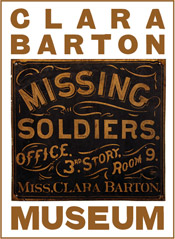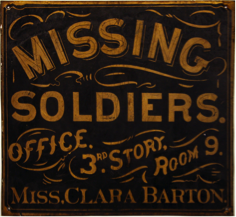Louisa May Alcott – Women’s History
Louisa May Alcott (1832-1888)
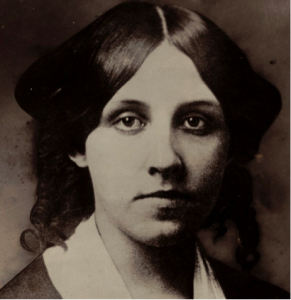 |
| Louisa May Alcott, 1857 |
Modern Americans remember Miss Alcott primarily as the author of the novel Little Women. Published in 1868, Little Women follows the lives of the four March sisters, Meg, Jo, Beth, and Amy, on the home front while their father serves as a chaplain during the Civil War. This work is autobiographical; the March family is strongly based on the Alcott family. Free-spirited, feisty Jo represents Louisa herself!
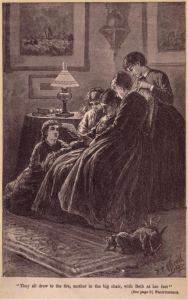 |
| An illustration from the 1880 edition of Little Women, Frank Merrill. |
As a whole, the Alcotts were progressively inclined, and Louisa’s reform-minded father Bronson was a friend of famed transcendentalist philosophers Ralph Waldo Emerson and Henry David Thoreau. All three of these men were liberal intellectuals who played a role in Louisa’s education and upbringing. This background predisposed her to advocate for social causes as an adult, including gender equality and the enfranchisement of women.
Throughout her youth, Louisa’s family moved frequently and even lived for a time in an unsuccessful utopian community called “Fruitlands” that Bronson had co-founded. They eventually settled down at Orchard House in Concord, Massachusetts, where they lived from 1858 to 1877. Orchard House has since been preserved and today, it looks much like it did when the Alcott family inhabited it.
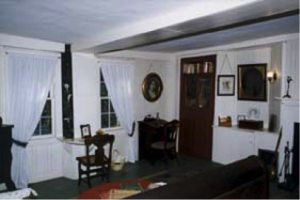 |
| Louisa’s Room at Orchard House, where she wrote Little Women. |
However, before she wrote Little Women, Miss Alcott served briefly as a nurse in Washington, D.C. for the Union Army. Although she spent only a short amount of time in service, she vividly immortalized her experiences in the Civil War through an autobiographical work entitled Hospital Sketches (1863). This work is told from the perspective of a character named “Tribulation Periwinkle.” In the following passage, she describes the anxiety-provoking daily life of a Civil War nurse.
“In they came, some on stretchers, some in men’s arms, some feebly staggering along propped on rude crutches, and one lay stark and still with covered face, as a comrade gave his name to be recorded before they carried him away to the dead house. All was hurry and confusion; the hall was full of these wrecks of humanity, for the most exhausted could not reach a bed till duly ticketed and registered; the walls were lined with rows of such as could sit, the floor covered with the more disabled, the steps and doorways filled with helpers and lookers on; the sound of many feet and voices made that usually quiet hour as noisy as noon; and, in the midst of it all, the matron’s motherly face brought more comfort to many a poor soul, than the cordial draughts she administered, or the cheery words that welcomed all, making of the hospital a home.” -Louisa May Alcott, Hospital Sketches, 1863
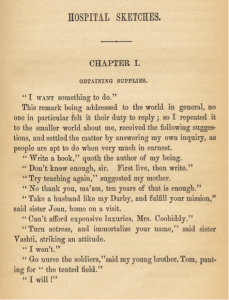 |
| A page from Alcott’s Hospital Sketches (1863). Boston Public Library Rare Books and Manuscripts Department |
Although Hospital Sketches helped launch Miss Alcott’s literary career, Little Women is undoubtedly her most beloved and enduring work. Not only does it highlight the familial love between four vastly different young ladies and their mother, but it also presents diverse representations of femininity. Meg, the eldest sister, happily aligns with society’s expectations of a Victorian-era woman, yet is not belittled for it. Socially inept and unusually masculine Jo, the second eldest, receives a similarly favorable treatment within the narrative. Although these two sisters present diametrically opposed expressions of womanhood, they are both depicted as respectable and moral. While Meg is conventionally domestic, she is not bland, and although Jo is subversively zealous, she is not sinister. Each sister is multifaceted and possesses a unique set of virtues, interests, and flaws, which suggests that there is not a singular ideal of femininity to which the young American woman must aspire.
As the real-life embodiment of Jo March, Louisa May Alcott was spirited, intelligent, and driven. Her talent and creativity enabled her to become both financially successful and well regarded, and her magnum opus, Little Women, has endured as a classic work of American literature. Today, she stands as one of the most successful female writers of the 19th century.
Sources Consulted:
Alcott, Louisa May. Hospital Sketches. Boston: James Redpath, 1863. Web. 2 March 2015. http://digital.library.upenn.edu/women/alcott/sketches/sketches.html#86
“Louisa May Alcott.” Natonal Women’s History Museum. Web. 3 March 2015. https://www.nwhm.org/education-resources/biography/biographies/louisa-may-alcott/
“Louisa May Alcott’s Orchard House: ‘Home of Little Women.’” Web. 3 March 2015. http://www.louisamayalcott.org/
Matteson, John. “Little Woman: The devilish, dutiful daughter Louisa May Alcott.” Humanities30.6 (2009). Web. 2 March 2015.
“Sisters of Mercy.” Boston Public Library. Web. 2 March 2015.
Posted in: Uncategorized